Building a brain that can read, part 2: Vocabulary and meaning

Executive Summary
- Beginning reading involves making connections between letters (orthography), sounds (phonology), and meaning (semantics)
- Automatic, fluent recognition of words depends on
- Developing these connections
- Practice reading words
- The development of the visual word form area in the brain
- The meaning of a word is distributed across the brain
- Although some words are taught directly, most are learned indirectly through encounters in texts
- The words that we know are our background knowledge; thus, vocabulary has consequences for comprehension
- Comprehension is an active, interactive, thoughtful set of processes that occur before, during, and after reading
Decoding: beyond sound and sight to meaning
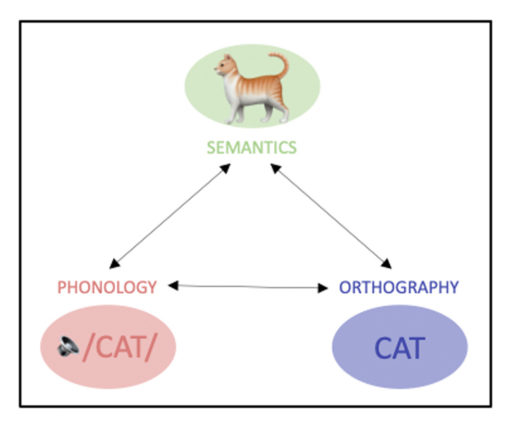
Figure 1. Beginning reading involves mappings among print (orthography), sound (phonology), and meaning (semantics).
The goal of beginning reading is to make meaning out of the marks on the page. In the first part of this brief (Building a brain that can read, part 1: sound and sight), decoding was described as the effortful process of considering each letter in a printed word, mapping it to a spoken speech sound, and then blending the sounds together in order to read the word. For example, in beginning reading, the written word cat on the page is read as /kuh/ /ahh/ /tuh/ and then those sounds are blended together into the spoken word cat. But there is another crucial piece: meaning1. As illustrated in Figure 1, beginning reading involves mappings among letters (orthography), the sounds of language (phonology), and meaning (semantics).
If the end product of decoding (in our example, the spoken word cat) is not already in the readers’ spoken vocabulary, reading fails. There is no meaning – no connection to the furry, purring, meowing animal. Decoding only serves its purpose if the beginning reader knows the meaning of the word they have just decoded. And, in beginning reading, they would only know the meaning if the word were already in their spoken vocabulary. This is one reason why having a substantial oral vocabulary is crucial to beginning reading: Learning to read builds on the spoken language system in terms of vocabulary knowledge. In turn, knowing the meaning of a word helps to learn its spelling-sound mappinge.g., 2. This is another example of one of the key insights from the science of learning: that new learning builds on prior knowledgee.g., 3,4,5.
From decoding to word-level fluency
The process of decoding may be “critical to the acquisition of word-specific orthographic representations”6, p. 95. That is, decoding is a stepping-stone to being able to fluently read words as words, without having to effortfully sound them oute.g., 7. Having sounded out a word a number of times, readers are more likely to recognize, remember, and automatically read that word on subsequent encounters; this is referred to as “self-teaching” in reading6,8. It involves the gradual development of automaticity: fast, effortless word recognition9. Note that this means that we read the same word in different ways, depending on how familiar we are with it. Consider how many words you can read accurately and automatically and how many words you were explicitly taught to read. Clearly, there has been some sort of self-teaching involved: You can read many more words than you were directly taught to read.
Overall, children rely less and less on decoding across the elementary school years, as automatic word processing develops with more exposure to printed wordse.g., 9,10.[1] In some curricula, words that have been learned and are read automatically, without the need for decoding, are known as “sight” or “by heart” words. It is important to note that just because such familiar words no longer need to be sounded out does not mean that phonology (sound) is no longer involved in the processing of these words. Rather, the neural representations of these words now include integrated orthographic, phonological, and meaning informatione.g., 12,13.[2] The process of orthographic mapping“involves formation of letter-sound connections to bond the spellings, pronunciations, and meanings of specific words in memory”7, p. 5. It is this integrated, multi-level memory of the word that is automatically activated by the orthography of a familiar word – by just seeing it in print.[3]
[1] Like decoding, other ways of reading unknown words, including reading by analogy to known words or predicting words from context, also shift attention to the word itself and away from the meaning of the text. “[B]eing able to read words automatically from memory is the most efficient, unobtrusive way to read words in text. Hence, building a sight word vocabulary is essential for achieving text-reading skill”11.
[2] In some languages, irregular words may also be “sight” words. Irregular words are words that do not follow the standard grapheme-phoneme correspondence rules, such that decoding fails; for example, the word yacht in English. But, even for these words, when known, orthographic, phonological, and meaning information are integrated.
[3] Activated by those letters in that order, not the overall shape or outline of the word. There is no evidence that words are processed by shape. Each letter of every word is visually processed in fluent readers, and beginning readers need to be taught to look at each letter for orthographic-phonological processing.
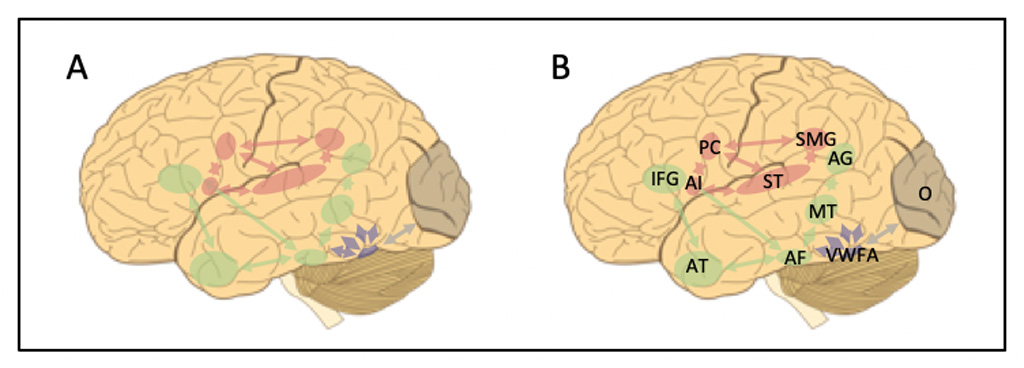
Figure 2. (A) Brain regions involved in phonological (speech sound) processing (shaded pink), basic visual processing (shaded gray), orthographic (letter spelling) processing (shaded purple), and semantic (meaning) processing (shaded green). All arrows are bi-directional. (B) Specific regions identified: ST (superior temporal), SMG (supramarginal gyrus), PC (precentral), AI (anterior insula); IFG (inferior frontal gyrus), AT (anterior temporal), AF (anterior fusiform), MT (middle temporal), AG (angular gyrus); O (occipital), VWFA (visual word form area). Based on and modified from Figure 2.2 in ref 19, available at https://readinginthebrain.pagesperso-orange.fr/figures
In the brain, this automatic activation via orthography likely occurs through neural connections between the visual word form area (see Building a brain that can read, part 1: sound and sight) and regions involved in sound and meaning processing for spoken language (see Figure 2)e.g., 14,15-19. Once again, we must build a brain that can read, borrowing from and building on systems that are specialized for other things, like spoken language processing. It is very likely that all of these connections are bi-directional. That is, information travels both to and from the visual word form area when reading a worde.g., 20.
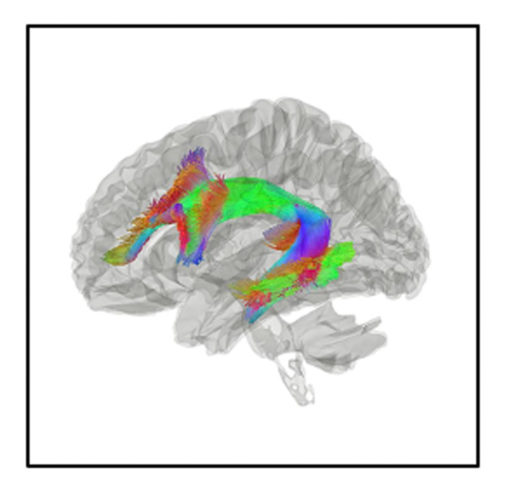
Figure 3. A left hemisphere view of the left arcuate fasciculus, a fiber bundle that connects regions of the brain involved in reading. Wikimedia Commons, source: brain.labsolver.org, CC BY-SA 4.0
Indeed, large bundles of fibers, called fasciculi, anatomically connect these regions.[4] Remarkably, learning to read leads to changes in these fiber bundles. Specifically, learning to read typically strengthens the left arcuate fasciculus(see Figure 3)18. In adults, the structure of this fiber bundle is associated with activation levels in both the visual word form area, to print, and the superior temporal lobe, to speech18. This suggests that these two regions and the connections between them work together as a system to process word information. In prereading and early reading kindergarten children, the size (volume) of the left arcuate fasciculus is correlated with phonological awareness: the larger the bundle, the better the skill21. And as children learn to read, fiber bundle maturation (including in the left arcuate fasciculus) and reading development are positively associated22. Thus, learning to read changes not only phonological and visual processing, but also the connections between them.
[4] These fibers are the axons of neurons, and serve both structural (making physical connections) and functional (processing information) purposes in the brain.
With these sorts of connections that allow for integrated memories for words, one part of a memory can automatically activate other parts of the memory. For example, young adults are slightly slower to say that the spoken words rye and tie rhyme than that the spoken words pie and tie rhyme, suggesting that they are accessing spelling (orthographic) information even though it is not relevant to the rhyme (phonological) task23. Similar effects have been seen in a brainwave recording study of rhyming in which incongruence between spelling and sound affected children more than adults24. Another brainwave recording study found that incongruence between spelling and sound affected processing even when neither was actually present in the task because the items to be rhymed were (meaningful) pictures25. Thus, spelling, sound, and meaning appear to be tightly integrated for well-known words.
What do we mean by meaning: semantics in the brain
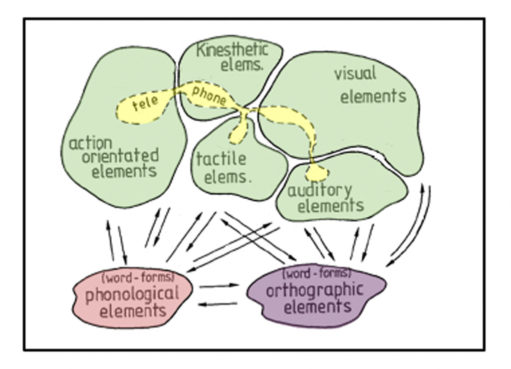
Figure 4. In addition to orthographic (shaded purple) and phonological (shaded pink) information, reading a word like telephone (yellow) can elicit semantic (meaning, shaded green) information across multiple modalities. Modified from ref 34, reprinted from Current perspectives in dysphasia, S.K. Newman and R. Epstein (Eds.), Distributed memory, modular systems and dysphasia, D.A. Allport (author), Elsevier (publisher), Figure 2.4, p. 53, © 1985.
Spoken and written words are processed for meaning in similar ways within one semantic system in the braine.g., 26,27. How this system works and is organized is complex and a matter of controversye.g., 28,29.
There is evidence that some components of the semantic system are distributed throughout the brain, in modality-specific regionse.g., 30,31-33. This is illustrated conceptually in Figure 4. For example, when we hear or read the word telephone, motor regions of the brain that are activated when we hold and dial our phones are reactivated, visual regions that are activated when we look at our phones are reactivated, auditory regions that are activated when we hear our phone ringing are reactivated, and so one.g., 33,34,35. Further, evidence from neuroimaging studies shows that words like cinnamon or salt elicit activation in neural regions that process taste and smell information36,37. Amazingly, this holds true even in idiomatic use of a word: Reading about grasping the idea or kicking the habitactivates the hand and foot regions of the motor cortex, respectively38. Findings like these contribute to the embodiedor grounded view of semantic memory28.
There is also evidence that some semantic processing is more localized. While distributed, modality-specific brain regions process semantic information as described above (for example, movement in the motor cortex, taste in the gustatory cortex, color in the visual cortex), an additional transmodal (across multiple modalities) or amodal (not associated with any one modality) brain region – a hub – may integrate that informatione.g., 39,40. This is known as the hub-and-spoke model of semantic memory because the modality-specific regions send and receive information to and from the hub through fiber bundles that are like the spokes of a wheele.g., 39. This is shown in Figure 5. In this model, the hub is in the anterior temporal lobe39. This might remind you of the semantic network in Figure 2 above, but with more detail.
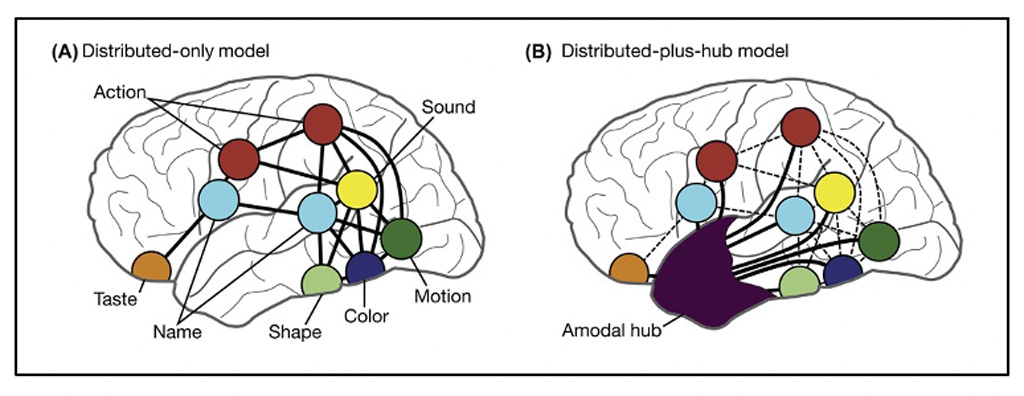
Figure 5. (A) The distributed model of semantic memory in which the semantic system is composed of a connected network (black lines) of sensorimotor systems processing various attributes and features. (B) The hub-and-spoke model of semantic memory in which an additional transmodal or amodal hub in the anterior temporal lobe (purple) integrates information from the distributed sensorimotor systems. Reprinted from Learning and memory: a comprehensive reference, 2nd Ed., Volume 3, chapter authors S.A. Nastase and J.V. Haxby, Structural basis of semantic memory, Figure 2, p. 138, © 2017, with permission from Elsevier. http://www.elsevier.com, http://dx.doi.org/10.1016/B978-0-12-809324-5.21073-0
The inclusion of a hub in the semantic system allows for generalization across concepts that are semantically similar but do not have similar attributes or features40. That is, it allows us to make meaningful connections between words that do not share modality-specific processing. For example, “[s]callops and prawns have different shapes, colours, shell structures, forms of movement, tastes, names, verbal descriptions, and so on, but semantically speaking, to seafood-eating humans they… have substantial conceptual overlap”40, p. 977. Integrative processing within the hub lets us recognize this overlap. In learning the meanings of words, we want children to go beyond just semantic features and attributes to be able to make such semantic generalizations.
What do we mean by meaning: vocabulary in education
By about fourth grade (ages 9 to 10 years old), most new words are learned from print rather than from speeche.g., 41. This does not mean that you should stop talking to your child once they enter the fourth grade! It just means that it becomes less likely that they will learn new vocabulary words from everyday spoken conversations with you. Because children learn most new words from encounters in texte.g., 42,43, they need to read widely, across different kinds of texts, to build and broaden their vocabulariese.g., 44,45.
Even then, there is only about a 10% chance that a reader will learn the meaning of a new word upon first encounter in a text42. Repeated exposures to a word across different contexts make it more likely to be learned, and learned well.
Experiencing words in diverse and meaningful language environments
is critical for the development of word reading skill… [because it allows
readers to] build knowledge of an individual word, not just of its spelling
and pronunciation, but knowledge of its meaning and how it connects
to other words. This rich knowledge base underpins reading fluency and
comprehension46, p. 1.
Words that are known well and have many links within the semantic system are considered established47. Words that readers feel they know something about, or have some sense of a connection to something known, are considered acquainted47. And words that readers have no familiarity with are considered unknown47. Unknown words are words that are waiting to be learned and find their place within the semantic network.
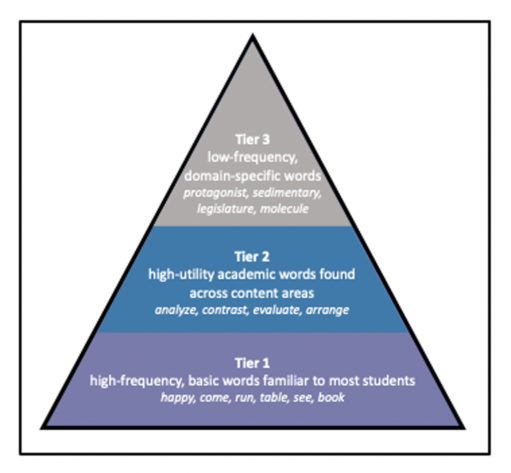
Figure 6. Three tiers of vocabulary. It is recommended to focus on Tier 2 words when choosing which words to teach directly. Based on ref 47.
While most words are learned indirectly through encounters in texts, some words are taught directly and explicitly. It is estimated that about 300-400 words per year (about 8-10 per week) can be taught explicitly47. With so few opportunities for direct instruction, teachers need to carefully choose the words that they will teach directly. Words that are central to the texts being used in the classroom, that will be useful for students to know, and that are key to a domain are strong choicese.g., 48. Generally, “Tier 2” words are good targets for explicit instruction47 (see Figure 6). These are high-utility, academic words that are used across content areas and will therefore offer many opportunities for practice and have many connections as they become established in long-term semantic memory47.
Whether learning indirectly or explicitly, repeated exposures to words in context must go beyond rote memorization of lists and dictionary definitionse.g., 49,50,51. Using multiple methods results in better vocabulary learning than using a single method49,51. For example, in the primary grades, whole-class repeated readings of books with teacher explanations of new vocabulary items improves student vocabulary knowledge52. Also, tasks such as analyzing the structure of a worde.g., 53,54,[5] considering denotative and connotative meanings, and generating antonyms and synonyms help to both deeply learn and remember a worde.g., 47,48,55. Graphic organizers like word maps or word webse.g., 56, Frayer diagramse.g., 57,58, or semantic fieldse.g., 59 support this type of word work (see Figures 7 and 8). The goal of such work is to develop a high quality word representation in long-term memory that integrates orthography, phonology, and many layers of meaninge.g., 12,13 and is situated within the semantic network with many connections to other words.
[5] Morphological analysis – recognizing the meaningful pieces of words like -chrono- (meaning time) or neuro- (meaning brain) in English – is crucial to learning to read and vocabulary development, but is not discussed here due to space limitations.
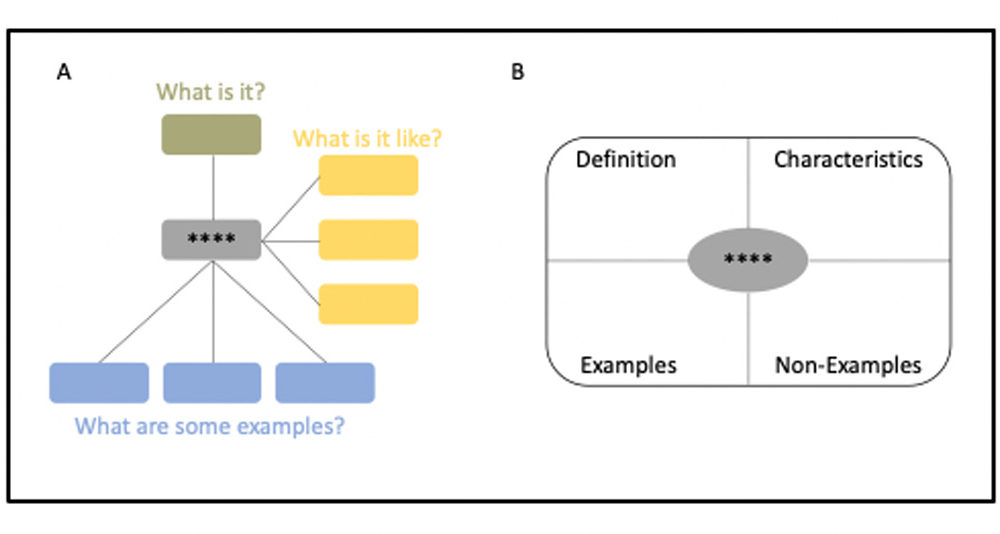
Figure 7. Examples of (A) a word map and (B) a Frayer diagram. If the target vocabulary item (****) in (A) were ice cream, it would be a dessert or a food, one example might be vanilla, and what it is like might be cold and sweet.
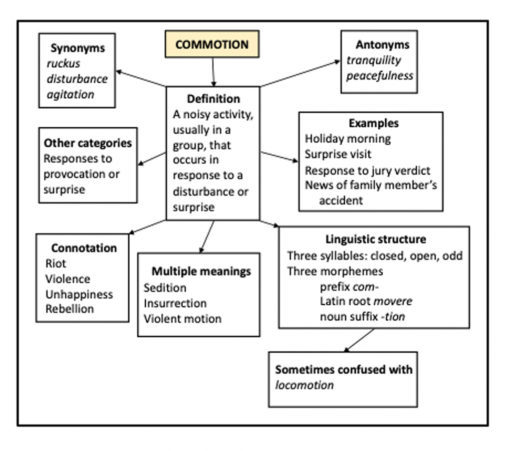
Figure 8. An example of a semantic field for the word commotion. Based on ref 59, p. 224, shading added. Source: Figure 7.3 “Semantic field for the word commotion” from Speech to Print, Third Edition by L.C. Moats. Copyright © 2020 by Paul H. Brookes Publishing Co., Inc. All rights reserved. With permission of the publisher. Book available from www.brookespublishing.com.
Vocabulary and conceptual knowledge are also organized in terms of schemase.g., 60,61. For example, read the following fragment that might begin a paragraph: When Mary arrived at the restaurante.g., 62. When you read the word restaurant, you automatically recall your knowledge about what happens in restaurants63. What other words come to mind as you read that word? Likely words that fit into the “restaurant schema,” like table, menu, waiter, order, eat, meal, food, bill, or paid. These are words closely connected to the word restaurant in your semantic long-term memory. If any of these words did appear in the rest of the paragraph, it would be easier for you to read them and make meaning of the text. By activating your “restaurant schema,” you have predicted what will come next in the text and primed yourself to expect those words (consciously or unconsciously). This is yet another example of how important prior knowledge is in readinge.g., 3,4,5. For children who have not had the opportunity to develop schemas (for example, due to lack of exposure to experiences or words), reading is more difficult.
A reader’s knowledge of the world depends on lived
experience. This is different in different countries,
regions and cultures. Reading tasks and reading
instruction should be sensitive to the types of prior
knowledge that are needed for the reader to
understand the text49, p. 13.
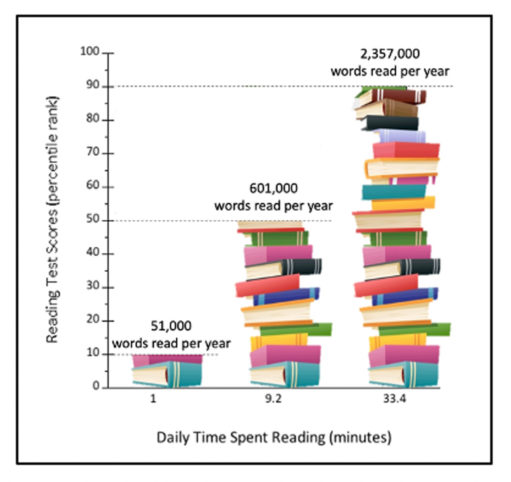
Figure 9. More time spent reading is related to more exposure to words and better reading skill. Minutes per day spent reading books, magazines, or newspapers outside of school, as self-reported by fifth-graders, and percentile rank on standardized reading tests are shown. Estimated words read per year through exposure to these texts is also reported. Based on ref 69, data in Table 3, p. 292.
Of course, teachers can help to build schemas and background knowledge; for example, by providing sets of texts that are conceptually coherent (for example, all on the same topic)e.g., 64. Reading instruction focused within a knowledge domain over time can build vocabulary, fluency, and motivation to reade.g., 65,66,67. Ultimately, because differences in exposure to written information contribute to differences in knowledge across individuals68, teachers have a role to play in providing texts to build knowledge – to build out the neural semantic network. It is not surprising that time spent reading, as in Figure 9, is one of the best predictors of both reading achievement and general knowledgee.g., 69,70.
Comprehension
The overall purpose of reading is to make meaningful connections with the text. When readers do not have to effortfully decode and word recognition happens automatically from memory, it frees resources (like attention and working memory) for focusing on the meaning of the text; that is, it frees resources for comprehensione.g., 7,9. Thus, word-level vocabulary knowledge, as discussed above, has consequences for text comprehensione.g., 13,71.
Comprehension is a set of active, interactive, and thoughtful processes by which a reader engages with a text to construct meaninge.g., 61,72-74. Comprehension develops through a dynamic interaction between the reader, the text, and the sociocultural contexte.g., 75,76. Readers may read “to learn, to find out information, to be entertained, to reflect, or as religious practice”49, p. 15. A reader’s purpose may affect their motivation to read, how much they read, and how widely they reade.g., 77. A recipe is read differently than a comic book, which is read differently than an instructional manual or a romance novel. Good comprehenders adapt and change their strategies for different kinds of texts and different purposes for reading.
Comprehension processes occur before, during, and after reading – not just at the end of a passage with reading comprehension questionse.g., 78. For example, good readers monitor their comprehension while they are reading, are aware of how well they understand a text, and use comprehension strategies to support their understanding of the texte.g., 79,80-83. These critical and inferential strategies include using prior knowledge (making use of the semantic system and schema), generating and answering questions, creating images from descriptions in the text, making predictions about what will come next in the text, clarifying when understanding falters (for example, by re-reading), and stopping to summarize periodically while readinge.g., 51,84. Learning about these strategies requires only brief instruction, but learning to use them in a purposeful way while reading requires more extensive practice and supporte.g., 82,85.[6]
[6] It is not necessary to wait until late elementary or middle school to expose children to these comprehension strategies. Indeed, dialogic reading with preschoolers who are not yet reading models many of these strategies, such as connecting to prior knowledge, making predictions, asking and answering questions, and stopping to summarize (see the brief in this series Emergent literacy: building a foundation for learning to read). This approach to reading with very young, pre-reading children also models that reading involves active interaction between reader and text.
Conclusion, parts 1 and 2
Overall, learning to read involves supporting a child in developing and coordinating many skills, different kinds of knowledge, and attitudes towards reading. It involves building a brain that can read, cultivating each of the contributing systems and connecting them to work together in the service of reading. It involves creating a knowledge base. Fundamentally, this requires experience with words and lots of practice with print, sound, meaning, and their integration. The developmental process of learning to read begins well before formal schooling and extends throughout the school years and beyonde.g., 86,87. In this sense, all teachers are teachers of reading. Finally, that we can learn to read at all is an example of the remarkable plasticity of the human brain and the capacity of biology to be shaped by culture.
References
- Adams, M. J. Beginning to read: thinking and learning about print. (MIT Press, 1990).
- Taylor, J. S. H., Duff, F. J., Woollams, A. M., Monaghan, P. & Ricketts, J. How word meaning influences word reading. Current Directions in Psychological Science 24, 322-328, doi:10.1177/0963721415574980 (2015).
- Deans for Impact. The science of learning. (Author, Austin, TX, 2015).
- Vosniadou, S. How children learn. Education Practices Series—7. (International Bureau of Education, International Academy of Education, Geneva, Switzerland, 2002).
- American Psychological Association & Coalition for Psychology in Schools and Education. Top 20 principles from psychology for preK-12 teaching and learning. (Washington, DC, 2015).
- Share, D. L. Phonological recoding and self-teaching: sine qua non of reading acquisition. Cognition 55, 51-218, doi:10.1016/0010-0277(94)00645-2 (1995).
- Ehri, L. C. Orthographic mapping in the acquisition of sight word reading, spelling memory, and vocabulary learning. Scientific Studies of Reading 18, 5-21, doi:10.1080/10888438.2013.819356 (2014).
- Share, D. L. Phonological recoding and orthographic learning: a direct test of the self-teaching hypothesis. J. Exp. Child Psychol. 72, 95-129, doi:10.1006/jecp.1998.2481 (1999).
- LaBerge, D. & Samuels, S. J. Toward a theory of automatic information processing in reading. Cognit. Psychol. 6, 293-323, doi:10.1016/0010-0285(74)90015-2 (1974).
- Doctor, E. A. & Coltheart, M. Children’s use of phonological encoding when reading for meaning. Mem. Cognit. 8, 195-209, doi:10.3758/BF03197607 (1980).
- Ehri, L. C. Learning to read words: theory, findings, and issues. Scientific Studies of Reading 9, 167-188, doi:10.1207/s1532799xssr0902_4 (2005).
- Perfetti, C. A. & Hart, L. The lexical quality hypothesis, in Precursors of functional literacy (eds L. Verhoeven, C. Elbro, & P. Reitsma) 189-213 (John Benjamins Publishing Company, 2002).
- Perfetti, C. A. Reading ability: lexical quality to comprehension. Scientific Studies of Reading 11, 357-383, doi:10.1080/10888430701530730 (2007).
- Chen, L. et al. The visual word form area (VWFA) is part of both language and attention circuitry. Nature Communications 10, 1-12, doi:10.1038/s41467-019-13634-z (2019).
- Bouhali, F. et al. Anatomical connections of the visual word form area. The Journal of Neuroscience 34, 15402-15414, doi:10.1523/JNEUROSCI.4918-13.2014 (2014).
- Stevens, W. D., Kravitz, D. J., Peng, C. S., Tessler, M. H. & Martin, A. Privileged functional connectivity between the visual word form area and the language system. The Journal of Neuroscience 37, 5288-5297, doi:10.1523/JNEUROSCI.0138-17.2017 (2017).
- Yeatman, J. D., Rauschecker, A. M. & Wandell, B. A. Anatomy of the visual word form area: adjacent cortical circuits and long-range white matter connections. Brain Lang. 125, 146-155, doi:10.1016/j.bandl.2012.04.010 (2013).
- Thiebaut de Schotten, M., Cohen, L., Amemiya, E., Braga, L. W. & Dehaene, S. Learning to read improves the structure of the arcuate fasciculus. Cereb. Cortex 24, 989-995, doi:10.1093/cercor/bhs383 (2014).
- Dehaene, S. Reading in the brain: the science and evolution of a human invention. (Viking, 2009).
- Twomey, T., Duncan, K. J. K., Price, C. J. & Devlin, J. T. Top-down modulation of ventral occipito-temporal responses during visual word recognition. Neuroimage 55, 1242-1251, doi:10.1016/j.neuroimage.2011.01.001 (2011).
- Saygin, Z. M. et al. Tracking the roots of reading ability: white matter volume and integrity correlate with phonological awareness in prereading and early-reading Kindergarten children. J. Neurosci. 33, 13251-13258, doi:10.1523/JNEUROSCI.4383-12.2013 (2013).
- Wang, Y. et al. Development of tract-specific white matter pathways during early reading development in at-risk children and typical controls. Cereb. Cortex 27, 2469-2485, doi:10.1093/cercor/bhw095 (2017).
- Seidenberg, M. S. & Tanenhaus, M. K. Orthographic effects on rhyme monitoring. J. Exp. Psychol. [Hum. Learn]. 5, 546-554, doi:10.1037//0278-7393.5.6.546 (1979).
- Weber-Fox, C., Spencer, R., Cuadrado, E. & Smith, A. Development of neural processes mediating rhyme judgments: phonological and orthographic interactions. Dev. Psychobiol. 43, 128-145, doi:10.1002/dev.10128 (2003).
- Coch, D. A picture is worth… both spelling and sound. Frontiers in Psychology 9, 1-12, doi:10.3389/fpsyg.2018.01490 (2018).
- Barsalou, L. W. Cognitive and neural contributions to understanding the conceptual system. Current Directions in Psychological Science 17, 91-95, doi:10.1111/j.1467-8721.2008.00555.x (2008).
- Booth, J. R. et al. Modality independence of word comprehension. Hum. Brain Mapp. 16, 251-261, doi:10.1002/hbm.10054 (2002).
- Hauk, O. What does it mean? A review of the neuroscientific evidence for embodied lexical semantics, in Neurobiology of language (eds G. Hickok & S.L. Small) 777-788 (Academic Press, 2016).
- Nastase, S. A. & Haxby, J. V. Structural basis of semantic memory, in Learning and memory: a comprehensive reference Vol. 3 (ed J.H. Byrne) 133-151 (Academic Press, 2017).
- Binder, J. R., Desai, R. H., Graves, W. W. & Conant, L. L. Where is the semantic system? A critical review and meta-analysis of 120 functional neuroimaging studies. Cereb. Cortex 19, 2767-2786, doi:10.1093/cercor/bhp055 (2009).
- Martin, A. The representation of object concepts in the brain. Annu. Rev. Psychol. 58, 25-45, doi:10.1146/annurev.psych.57.102904.190143 (2007).
- Martin, A. & Chao, L. L. Semantic memory and the brain: structure and processes. Curr. Opin. Neurobiol. 11, 194-201, doi:10.1016/S0959-4388(00)00196-3 (2001).
- Thompson-Schill, S. L. Neuroimaging studies of semantic memory: inferring “how” from “where”. Neuropsychologia 41, 280-292, doi:10.1016/S0028-3932(02)00161-6 (2003).
- Allport, D. A. Distributed memory, modular systems, and dysphasia, in Current perspectives in dysphasia (eds S.K. Newman & R. Epstein) 32-60 (Churchill Livingstone, 1985).
- Goldberg, R. F., Perfetti, C. A. & Schneider, W. Distinct and common cortical activations for multimodal semantic categories. Cognitive, Affective, & Behavioral Neuroscience 6, 214-222, doi:10.3758/CABN.6.3.214 (2006).
- Barrós-Loscertales, A. et al. Reading salt activates gustatory brain regions: fMRI evidence for semantic grounding in a novel sensory modality. Cereb. Cortex 22, 2554-2563, doi:10.1093/cercor/bhr324 (2012).
- González, J. et al. Reading cinnamon activates olfactory brain regions. Neuroimage 32, 906-912, doi:10.1016/j.neuroimage.2006.03.037 (2006).
- Boulenger, V., Hauk, O. & Pulvermüller, F. Grasping ideas with the motor system: semantic somatotopy in idiom comprehension. Cereb. Cortex 19, 1905-1914, doi:10.1093/cercor/bhn217 (2009).
- Patterson, K. & Lambon Ralph, M. A. The hub-and-spoke hypothesis of semantic memory, in Neurobiology of language (eds G. Hickok & S.L. Small) 765-775 (Academic Press, 2016).
- Patterson, K., Nestor, P. J. & Rogers, T. T. Where do you know what you know? The representation of semantic knowledge in the human brain. Nature Reviews Neuroscience 8, 976-987, doi:10.1038/nrn2277 (2007).
- Nippold, M. A. Later language development: the school-age and adolescent years. 2nd edn, (Pro-Ed, 1998).
- Nagy, W. & Anderson, R. C. How many words are there in printed school English? Reading Research Quarterly 19, 304-330, doi:10.2307/747823 (1984).
- Nagy, W. E., Anderson, R. C. & Herman, P. A. Learning word meanings from context during normal reading. American Educational Research Journal 24, 237-270, doi:10.3102/00028312024002237 (1987).
- Kuhn, M. R., Schwanenflugel, P. J. & Meisinger, E. B. Aligning theory and assessment of reading fluency: automaticity, prosody, and definitions of fluency. Reading Research Quarterly 45, 230-251, doi:10.1598/RRQ.45.2.4 (2010).
- Nagy, W. E. & Herman, P. A. in The nature of vocabulary acquisition (eds M.G. McKeown & M.E. Curtis) 19-35 (Lawrence Erlbaum Associates, Inc., 1987).
- Nation, K. Nurturing a lexical legacy: reading experience is critical for the development of word reading skill. Science of Learning 2, 1-4, doi:10.1038/s41539-017-0004-7 (2017).
- Beck, I. L., McKeown, M. G. & Kucan, L. Bringing words to life: robust vocabulary instruction. 2nd edn, (Guilford Press, 2013).
- Moats, L. C. Speech to print: language essentials for teachers. (Paul H. Brookes, 2000).
- Pang, E. S., Muaka, A., Bernhardt, E. B. & Kamil, M. L. Teaching reading. Education Practices Series—12. (International Bureau of Education, International Academy of Education, Geneva, Switzerland, 2003).
- Templeton, S. et al. Vocabulary their way: word study with middle and secondary students. 2nd edn, (Pearson, 2015).
- National Institute of Child Health and Human Development. Report of the National Reading Panel. Teaching children to read: an evidence-based assessment of the scientific research literature on reading and its implications for reading instruction (NIH Publication No. 00-4769). (U.S. Government Printing Office, Washington, DC, 2000).
- Biemiller, A. & Boote, C. An effective method for building meaning vocabulary in primary grades. J. Educ. Psychol. 98, 44-62, doi:10.1037/0022-0663.98.1.44 (2006).
- Carlisle, J. F. Morphology matters in learning to read: a commentary. Reading Psychology 24, 291-322 (2003).
- Rastle, K. The place of morphology in learning to read English. Cortex 116, 45-54, doi:10.1016/j.cortex.2018.02.008 (2019).
- Ford-Connors, E. & Paratore, J. R. Vocabulary instruction in fifth grade and beyond: sources of word learning and productive contexts for development. Review of Educational Research 85, 50-91, doi:10.3102/0034654314540943 (2015).
- Schwartz, R. M. & Raphael, T. E. Concept of definition: a key to improving students’ vocabulary. The Reading Teacher 39, 198-205 (1985).
- Frayer, D. A., Frederick, W. C. & Klausmeier, H. J. A schema for testing the level of concept mastery. (University of Wisconsin Research and Development Center for Cognitive Learning, Madison, WI, 1969).
- Frayer, D. A., Ghatala, E. S. & Klausmeier, H. J. Levels of concept mastery: implications for instruction. Educational Technology 12, 23-29 (1972).
- Moats, L. C. Speech to print: language essentials for teachers. (Paul H. Brookes Publishing Co., 2020).
- Anderson, R. C. & Pearson, P. D. A schema-theoretic view of basic processes in reading comprehension, in Handbook of reading research (eds P.D. Pearson, R. Barr, M.L. Kamil, & P.B. Mosenthal) 255-291 (Cambridge University Press, 1984).
- Kintsch, W. The role of knowledge in discourse comprehension: a construction-integration model. Psychol. Rev. 95, 163-182, doi:10.1037/0033-295X.95.2.163 (1988).
- Frankel, K. K., Becker, B. L. C., Rowe, M. W. & Pearson, P. D. From “what is reading?” to what is literacy? Journal of Education 196, 7-17, doi:10.1177/002205741619600303 (2016).
- Anderson, R. C., Hiebert, E. H., Scott, J. A., Wilkinson, I. A. G. & members of the Commission on Reading. Becoming a nation of readers: the report of the Commission on Reading. 1-155 (University of Illinois, Champaign, IL, 1985).
- Cervetti, G. N., Wright, T. S. & Hwang, H. Conceptual coherence, comprehension, and vocabulary acquisition: a knowledge effect? Reading & Writing 29, 761-779, doi:10.1007/s11145-016-9628-x (2016).
- Guthrie, J. T., Anderson, E., Alao, S. & Rinehart, J. Influence of concept-oriented reading instruction on strategy use and conceptual learning from text. The Elementary School Journal 99, 343-366, doi:10.1086/461929 (1999).
- Guthrie, J. T., Wigfield, A. & VonSecker, C. Effects of integrated instruction on motivation and strategy use in reading. J. Educ. Psychol. 92, 331-341, doi:10.1037//9022-0663.92.2,331 (2000).
- Guthrie, J. T., McRae, A. & Klauda, S. L. Contributions of Concept-Oriented Reading Instruction to knowledge about interventions for motivations in reading. Educational Psychologist 42, 237-250, doi:10.1080/00461520701621087 (2007).
- Stanovich, K. E. & Cunningham, A. E. Where does knowledge come from? Specific associations between print exposure and information acquisition. J. Educ. Psychol. 85, 211-229, doi:10.1037/0022-0663.85.2.211 (1993).
- Anderson, R. C., Wilson, P. T. & Fielding, L. G. Growth in reading and how children spend their time outside of school. Reading Research Quarterly 23, 285-303, doi:10.1598/RRQ.23.3.2 (1988).
- Cunningham, A. E. & Stanovich, K. E. What reading does for the mind. American Educator 22, 8-15 (1998).
- Hirsch Jr., E. D. Reading comprehension requires knowledge – of words and the world. American Educator27, 10-13, 16-22, 28-29, 48 (2003).
- Perfetti, C. A., Van Dyke, J. & Hart, L. The psycholinguistics of basic literacy. Annual Review of Applied Linguistics 21, 127-149, doi:10.1017/S0267190501000083 (2001).
- Rapp, D. N. & van den Broek, P. Dynamic text comprehension: an integrative view of reading. Current Directions in Psychological Science 14, 276-279, doi:10.1111/j.0963-7214.2005.00380.x (2005).
- van den Broek, P. Using texts in science education: cognitive processes and knowledge representation. Science 328, 453-456, doi:10.1126/science.1182594 (2010).
- Pardo, L. S. What every teacher needs to know about comprehension. The Reading Teacher 58, 272-280 (2004).
- Connor, C. M. A lattice model of the development of reading comprehension. Child Development Perspectives 10, 269-274, doi:10.1111/cdep.12200 (2016).
- Wigfield, A. & Guthrie, J. T. Relations of children’s motivation for reading to the amount and breadth of their reading. J. Educ. Psychol. 89, 420-432, doi:10.1037/0022-0663.89.3.420 (1997).
- Crafton, L. K. Comprehension before, during, and after reading. The Reading Teacher 36, 293-297 (1982).
- Paris, S. G., Lipson, M. Y. & Wixson, K. K. Becoming a strategic reader. Contemp. Educ. Psychol. 8, 293-316, doi:10.1016/0361-476X(83)90018-8 (1983).
- Palinscar, A. S. & Brown, A. L. Reciprocal teaching of comprehension-fostering and comprehension-monitoring activities. Cognition and Instruction 1, 117-175, doi:10.1207/s1532690xci0102_1 (1984).
- Brown, A. L., Palinscar, A. S. & Armbruster, B. B. Instructing comprehension-fostering activities in interactive learning situations, in Learning and comprehension of text (eds H. Mandl, N.L. Stein, & T. Trabasso) 255-286 (Lawrence Erlbaum, 1984).
- Rosenshine, B. & Meister, C. Reciprocal teaching: a review of the research. Review of Educational Research 64, 479-530, doi:10.2307/1170585 (1994).
- Pressley, M., Johnson, C. J., Symons, S., McGoldrick, J. A. & Kurita, J. A. Strategies that improve children’s memory and comprehension of text. The Elementary School Journal 90, 3-32 (1989).
- Shanahan, T. The National Reading Panel report: practical advice for teachers. (Learning Point Associates, Naperville, IL, 2005).
- Willingham, D. T. The usefulness of brief instruction in reading comprehension strategies. American Educator, 39-45, 50 (2006-2007).
- Biancarosa, G. & Snow, C. Reading next – a vision for action and research in middle and high school literacy: a report to the Carnegie Corporation of New York. (Alliance for Excellent Education, Washington, DC, 2004).
- Snow, C. E., Burns, M. S. & Griffin, P. Preventing reading difficulties in young children. (National Academy Press, Washington, DC, 1998).